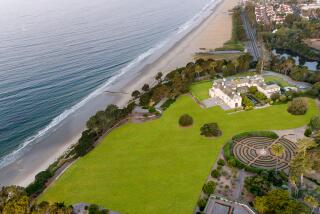In the Playboy Mansion, Hugh Hefner created a house of hedonism that may not survive him
The Gothic Tudor was one of many estates built for Los Angeles’ wealthy class during the boom years of the 1920s, an ornate European revival sitting slightly out of place in a Westside canyon.
But in the 1970s, Playboy publisher Hugh Hefner saw the Holmby Hills home as a chance to create a hedonistic headquarters for a business that peddled photos of nude women and a sexually liberated lifestyle that would spark decades of debate.
During the height of its popularity, the Playboy Mansion was perhaps L.A.’s most famous home. Attending one of Hefner’s parties was a sign of status, where one could rub elbows with celebrities, Playboy “Bunnies” and the host himself, often dressed in his trademark pajamas.
The fortunes of Playboy waned over the years, and the free sex ethos that the mansion symbolized eventually became viewed by many as cruelly exploitative of women and reckless in an era of AIDS.
But Hefner remained behind the mansion’s gates until the very end, even after he sold it last year for $100 million. It was there that he died Wednesday at age 91.
It’s unclear what will become of the estate now — or even whether there can be a Playboy Mansion without Hefner.
Recent visitors have been quick to point out the mansion tended to trade on its risqué reputation more than live up to it.
It became a popular spot for both private parties and political and charity fundraisers. In 2005, the mansion was the setting for an E! reality show in which Hefner lived with three much younger companions.
But there were periodic reminders of its darker past. Women came forward with stories of cruel behavior and a blatantly sexist culture. The mansion was back in the news in 2014 when a woman claimed Bill Cosby molested her during a party there in 1974.
For some, a visit to the mansion was an official introduction to Hollywood, underbelly and all.
In 1985, when the mansion was reveling in its salacious reputation, aspiring singer Michele Hart snuck in with her friends. She was 19 years old and had just moved to Los Angeles from Texas.
The theme at the mansion that night was Midsummer’s Night lingerie. Too shy to wear just one see-through bodysuit, Hart said she piled on two more. But then she encountered a scene where being naked was the norm and celebrities milled about aimlessly.
“There was so much sex and drugs and rock and roll going on, my eyes couldn’t fathom it,” Hart recalled. “The grotto was this big orgy scene.”
At one point someone came up behind her and exclaimed: “Your red hair is the most beautiful I have ever seen! Anyone can be a blonde; only special people are chosen to be redheads.”
It was Hefner.
“I just remember feeling I was validated in Hollywood,” Hart said.
And perhaps that is what Hefner intended.
Historian Elizabeth Fraterrigo, an associate professor of history at Loyola University Chicago who wrote a book on Playboy’s influence in gender and popular culture in post-war America, said the mansion became emblematic of the lifestyle Hefner lived and promoted through his magazine.
“It was both a private residence but had this really strong corporate function,” said Fraterrigo, who spent time in the mansion in 2008 and 2009 reviewing Hefner’s scrapbooks for her book. “For people of a certain generation, it has this iconic presence in popular culture.”
The home was built in 1927 for department store scion Arthur Letts Jr. Hefner bought it for about $1.1 million and transformed it into his own.
Today, the mansion has 29 rooms. The property has its own zoo license and is filled with exotic birds, even monkeys.
While working on-site at the mansion, Fraterrigo said she was struck by how the notorious party house was mostly a corporate-feeling workplace during the day.
New York University Law Professor Burt Neuborne was at the mansion last year to accept the Hugh M. Hefner First Amendment Award.
Neuborne’s friends joked to him that his heart might not hold up if the Playboy Bunnies dropped by.
“Truthfully I had looked forward to seeing something that was an interesting symbol and memory of what he stood for — a kind of hedonism,” Neuborne said in an interview.
“I was prepared to be shocked but also look with interest.”
In the end, Neuborne said, the affair held on the rolling lawn behind the mansion was decidedly tame and Hefner didn’t attend.
Behind the reputation as a party playground, there was an intimate side to the mansion that took hold as Hefner aged. For years, a select group of people had an open invitation to visit every Friday, Saturday and Sunday to watch movies on a giant screen. Guests would first enjoy a buffet dinner of Hefner’s favorites: steak, lobster, roast beef, fried chicken, mashed potatoes. Then everyone would settle into the living room onto leather sofas for a film that might be a Rock Hudson classic or a new release in theaters. Afterward, coffee and a selection of desserts, such as banana cream pie, were shared.
“The mansion wasn’t the mansion for us — it wasn’t an event center. It was his home,” said Monika Henreid, who attended the gatherings over the last decade.
“It was cozy and warm. For him the enjoyment was watching other people enjoy themselves. He wanted them to have a glass of champagne and a good dinner. I would watch him sit back and just beam.”
Henreid is the daughter of the actor who played Victor Laszlo in “Casablanca” — Hefner’s favorite film. It was the theme of many of his birthday parties, including his very last one.
More to Read
Sign up for Essential California
The most important California stories and recommendations in your inbox every morning.
You may occasionally receive promotional content from the Los Angeles Times.













